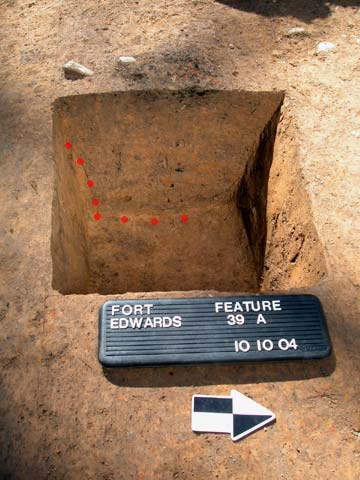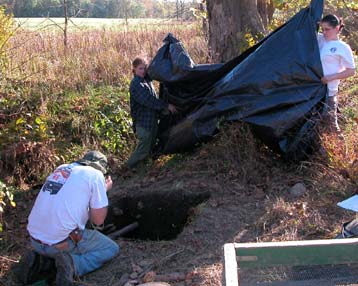Daily Report, October 10, 2004

 Today we went back to the first of the two major areas we are investigating and began to extend the excavation. The two yellow arrows show two concentrations of rocks that may indicate something like a fallen chimney, a cellar or a foundation. The stockade wall with its in-wall bastion abutted one of these features. We are still trying to discover whether the wall predated the cellar type feature or whether the stockade came later. The red arrow shows one prominent feature edge where the darker dirt of a feature protrudes into the lighter clay. An enlargement is shown to the right with red dots emphasizing the line of demarkation. Today we went back to the first of the two major areas we are investigating and began to extend the excavation. The two yellow arrows show two concentrations of rocks that may indicate something like a fallen chimney, a cellar or a foundation. The stockade wall with its in-wall bastion abutted one of these features. We are still trying to discover whether the wall predated the cellar type feature or whether the stockade came later. The red arrow shows one prominent feature edge where the darker dirt of a feature protrudes into the lighter clay. An enlargement is shown to the right with red dots emphasizing the line of demarkation.
We also began to extend our search of the burn feature outside the stockade wall. It is feature #60.

This feature had revealed an eighteenth century bottle base on the second day, so we were hopeful of finding more artifacts. We were not disappointed. In the upper right of the feature can be seen an artifact that has us puzzled. To left of center are two artifacts just being cleared. Below them near the sign are two bone fragments. Three of the artifacts are shown in detail below.
Artifacts of the Day

This appears to be a fireplace or kitchen tool, but we are not sure yet. It is about 8 inches wide.

This is an intact bottle neck which we will be able to date because of its particular shape. The flat round object is made of lead. Sometimes soldiers would flatten a musket ball to use as a chip for game playing.
The picture below is a closeup of some of the parts of the burn feature. The black is charcoal; the red-orange is earth that has been heated by a very hot fire.

Visitor of the Day

Our special visitor of the day was Ken Edmonds. Ken was one of the men who founded our organization, and he served as our first President of the Foundation. We were glad he still keeps wp with all the work of the Foundation. A while ago he moved closer to Col. Washington's headquarters fort, Fort Loudoun.
 
The photo above left shows the section of stockade wall opened in 2001. The red dots outline the stockade wall feature. The small pit (seen in detail on the right) reveals a section of the feature so we can see its shape and depth below the height we have currently excavated it. In the background the team is screening the dirt from this section pit and surrounding areas to look for small artifacts.
 
Here we see the progress that Myrisa has made on the one meter square pit. She has reached the level that we are interested in and has not found anything of note. We will perhaps try another pit somewhere else. The first photo shows Myrisa and Rebecca holding up black plastic to shade the hole while David McBride photographs it. Too much sun washes out the color in our pictures.

At the end of each day we cover the work with plastic to protect it. When we finish our dig at the end of the week, we will cover all the features with plastic like this before we fill in the holes with dirt to protect them until we come back for more investigation. Then, we will be able to find each feature by digging down until we hit plactic. The features will be protected under it.
|

 Today we went back to the first of the two major areas we are investigating and began to extend the excavation. The two yellow arrows show two concentrations of rocks that may indicate something like a fallen chimney, a cellar or a foundation. The stockade wall with its in-wall bastion abutted one of these features. We are still trying to discover whether the wall predated the cellar type feature or whether the stockade came later. The red arrow shows one prominent feature edge where the darker dirt of a feature protrudes into the lighter clay. An enlargement is shown to the right with red dots emphasizing the line of demarkation.
Today we went back to the first of the two major areas we are investigating and began to extend the excavation. The two yellow arrows show two concentrations of rocks that may indicate something like a fallen chimney, a cellar or a foundation. The stockade wall with its in-wall bastion abutted one of these features. We are still trying to discover whether the wall predated the cellar type feature or whether the stockade came later. The red arrow shows one prominent feature edge where the darker dirt of a feature protrudes into the lighter clay. An enlargement is shown to the right with red dots emphasizing the line of demarkation.









